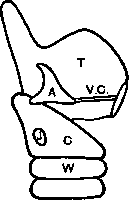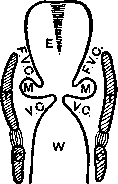Voice Training In Speech And Song - online tutorial
The Structure And Use Of The Vocal Organs, And The Means Of Securing Distinct Articulation.
| Share page | Visit Us On FB |
|
10 THE VIBRATORY APPARATUS.
angle of the thyroid to the vocal process of the arytenoid (Fig. 4) ; they are half an inch in length in the female and three-quarters of an inch in the male. |
|||
 |
 |
||
|
|
|||
|
|
|||
|
Fig. 4.—Inside of Larynx. |
Fig. 5.—Section of Larynx. |
||
|
|
|||
|
|
|||
|
Showing VC, Vocal Cords, passing from angle of T, Thyroid, to front process of A, Arytenoid. The right wing of the Thyroid Cartilage has been removed. C, Cricoid Cartilage, narrow in front, wide behind, with J, depression for joint with Thyroid ; W, Windpipe. |
Showing relationship of VC, Vocal Cords, and FVC, False Vocal Cords, to M, Ventricle of Morgagni; also the shape of the vocal tube through which the air passes. T, Thyroid Cartilage ; C, Cricoid Cartilage ; E, Epiglottis; W, Windpipe. Notice triangular shape of the Vocal Cords. |
||
|
16. The False Cords.—The false vocal cords are two folds of mucous membrane, one on each side of the larynx just above the vocal cords (Fig. 5) ; they contain many glands which secrete a fluid to moisten the vocal cords, and they are separated from the vocal cords by a space (ventricle of Morgagni) which allows room for the vibration of the cords (Fig. 5).
17. The Glottis.—The glottis is the space or chink between the vocal cords, which varies in shape and size (Figs. 6 and 7). In the breathing of repose the shape is that of an ellipse. In the fuller breathing of action or |
|||